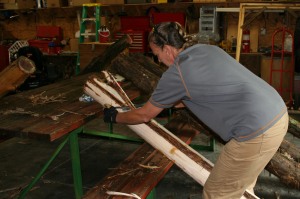
Building a fence out of your own trees isn’t the easiest way to do things.
My li’l ole fence out front along the road has garnered many compliments because it looks damn nice, and really stands out among the pressure-treated, milled lumber, commercially-installed versions in the area; but its true beauty in my view is its humble, local origin. And that it was built by my own hands. From my own trees.
Most folks around here probably think that viewpoint’s a little off. Too much work, nicer materials right down there at Lowes; why go to all the bother. I admit, it would have been much easier just to call someone out and pay them to slap something up. It would have met the minimum objectives as well, which was to keep vehicles from driving up to the house and shop building, thus making the place more secure.
But it wouldn’t have been a thing of beauty, or have the potential to last 25 -30 years like this one will, or given me any of the satisfaction I’ll feel every single time I lay eyes on it and remember how we built it from cedars and hardwoods cut off the hill above.
Arguments for saving time and effort aside, I’m just not interested in paying someone to do work that I enjoy doing and can do well myself, especially on a project that designs itself as it goes; nor am I at all keen to buy mass-produced, trucked-in, chemically-treated materials when I have raw materials in abundance in my own backyard.
Sounds a little pious, perhaps too idealistic, I suppose. I will readily admit that this commitment to doing my own work and using my own materials as much as possible has its drawbacks, not the least of which is the multiplication of effort and time in any project equation. But I’m pretty stubborn, and not afraid of slow, hard work, and so I accept that building something from scratch means doing things “the hard way” with hand tools, sometimes, and a great deal more effort than needed with “modern” methods and commercial materials.
I may not be able to take this approach every time. The porch, for instance, was built with pressure-treated lumber, after much thought and deliberation about the pros and cons of using non-treated lumber in that climate for that type of application. But my pasture fences will need to be non-toxic, in the big scheme of operating a certified organic farm, and so this small section was a test bed for my ideas of how to use locally harvested, untreated posts in the Kentucky soil without compromising on fence longevity.
What I didn’t know before Skidder and I took that first walk up the hill to survey for materials, was that I had a good number of mature eastern red cedar trees (Juniperus virginiana) at their climax of growth potential, having been overtaken by taller hardwoods and fairly begging to be made into fence and gateposts before their wood began declining as they lost the battle for sunlight, water and nutrients. And while this tree is not a true cedar, but a member of the juniper family, it does have superior rot-resistance – especially in the red heartwood – not as much rot resistance as black locust, but more than any other hardwood species I might have had to use.
We took four 8 – 9″ gate posts and nine 6 – 7″ fence posts off the south-facing hill just around the corner from the shop. I believe I felled a total of eight trees, for the posts. One was quite large, leaving me a lovely 10-foot timber that will make some fine slabs for sign-making and bench-building. Skidder pulled most of them down the hill by herself while I cut. We worked furiously in the morning rain, thinking it might go on all day and wanting to get the logs down to the shop so we could peel them inside. But the rain stopped as we finished, which wasn’t a bad thing.
Next: peeling with spud and draw knife.
Read Full Post »
 Again, it depends on what you compare it to. We caught on pretty quickly and learned how to position the logs against a sturdy picnic table, and let the tools do most of the work instead of our backs. The last couple of rails I peeled went much faster than the first two. We weren’t putting up hundreds of feet of fence, so peeling the logs and rails by hand wasn’t a show-stopper for the limited amount of time we had; I’d say it was neither slow nor fast – just right.
Again, it depends on what you compare it to. We caught on pretty quickly and learned how to position the logs against a sturdy picnic table, and let the tools do most of the work instead of our backs. The last couple of rails I peeled went much faster than the first two. We weren’t putting up hundreds of feet of fence, so peeling the logs and rails by hand wasn’t a show-stopper for the limited amount of time we had; I’d say it was neither slow nor fast – just right.

